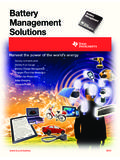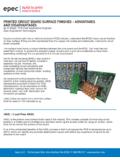Transcription of Lithium Battery Packing Instruction
1 Chapter 11 4-11-23 2015-2016 EDITION Packing Instruction 965 Passenger and cargo aircraft for UN 3480 1. Introduction This entry applies to Lithium ion or Lithium polymer batteries. This Packing Instruction is structured as follows: Section IA applies to Lithium ion cells with a Watt-hour rating in excess of 20 Wh and Lithium ion batteries with a Watt-hour rating in excess of 100 Wh, which must be assigned to Class 9 and are subject to all of the applicable requirements of these Instructions; Section IB applies to Lithium ion cells with a Watt-hour rating not exceeding 20 Wh and Lithium ion batteries with a Watt-hour rating not exceeding 100 Wh packed in quantities that exceed the allowance permitted in Section II, Table 965-II; and Section II applies to Lithium ion cells with a Watt-hour rating not exceeding 20 Wh and Lithium ion batteries with a Watt-hour rating not exceeding 100 Wh packed in quantities not exceeding the allowance permitted in Section II, Table 965-II.
2 2. Lithium batteries forbidden from transport The following applies to all Lithium ion cells and batteries in this Packing Instruction : Cells and batteries, identified by the manufacturer as being defective for safety reasons, or that have been damaged, that have the potential of producing a dangerous evolution of heat, fire or short circuit are forbidden for transport ( those being returned to the manufacturer for safety reasons). Waste Lithium batteries and Lithium batteries being shipped for recycling or disposal are forbidden from air transport unless approved by the appropriate national authority of the State of Origin and the State of the Operator. IA. SECTION IA Each cell or Battery must meet all the provisions of 2; General requirements Part 4;1 requirements must be met. Table 965-IAUN number and proper shipping nameNet quantity per packagePassengerCargoUN 3480 Lithium ion batteries5 kg35 kg > > 4-11-24 Part 4 2015-2016 EDITION Packing Instruction 965 Additional requirements Lithium ion cells and batteries must be protected against short circuits.
3 Lithium ion cells and batteries must be placed in inner packagings that completely enclose the cell or Battery then placed in an outer packaging. The completed package for the cells or batteries must meet the Packing Group II performance requirements. Lithium ion batteries with a mass of 12 kg or greater and having a strong, impact-resistant outer casing, or assemblies of such batteries, may be transported when packed in strong outer packagings or protective enclosures ( in fully enclosed or wooden slatted crates) not subject to the requirements of Part 6 of these Instructions, if approved by the appropriate authority of the State of Origin. A copy of the document of approval must accompany the consignment. Batteries manufactured after 31 December 2011 must be marked with the Watt-hour rating on the outside case. Outer packagings Boxes DrumsJerricans Aluminium (4B) Aluminium (1B2)Aluminium (3B2) Fibreboard (4G) Fibre (1G)Plastics (3H2) Natural wood (4C1, 4C2) Other metal (1N2)Steel (3A2) Other metal (4N) Plastics (1H2)Plastics (4H1, 4H2) Plywood (1D)Plywood (4D) Steel (1A2)Reconstituted wood (4F) Steel (4A) IB.
4 SECTION IB Quantities of Lithium ion cells or batteries that exceed the allowance permitted in Section II, Table 965-II are subject to all of the applicable provisions of these Instructions (including the requirements in paragraph 2 of this Packing Instruction and of this section) except for the the provisions of Part 6. Lithium ion cells or batteries shipped in accordance with the provisions of Section IB must be described on a dangerous goods transport document as set in Part 5;4. The Packing Instruction number 965 required by 5; a) must be supplemented with IB . All other applicable provisions of Part 5;4 apply. Lithium ion cells and batteries may be offered for transport provided that each cell and Battery meets the provisions of 2; a) and e) and the following: 1) for Lithium ion cells, the Watt-hour rating (see the Glossary of Terms in Attachment 2) is not more than 20 Wh; 2) for Lithium ion batteries, the Watt-hour rating is not more than 100 Wh; the Watt-hour rating must be marked on the outside of the Battery case except for those batteries manufactured before 1 January 2009; General requirements Cells and batteries must be packed in strong outer packagings that conform to Part 4; , and (except ).
5 Table 965-IB ContentsNet quantity per package PassengerCargoLithium ion cells and batteries10 kg10 kg > + > >Chapter 11 4-11-25 2015-2016 EDITION Packing Instruction 965 Additional requirements Cells and batteries must be packed in inner packagings that completely enclose the cell or Battery then placed in a strong outer packaging. Cells and batteries must be protected so as to prevent short circuits. This includes protection against contact with conductive materials within the same packaging that could lead to a short circuit. Each package must be capable of withstanding a m drop test in any orientation without: damage to cells or batteries contained therein; shifting of the contents so as to allow Battery to Battery (or cell to cell) contact; release of contents. Each package must be labelled with a Lithium Battery handling label (Figure 5-32) in addition to the Class 9 hazard label.
6 Each consignment must be accompanied with a document with an indication that: the package contains Lithium ion cells or batteries; the package must be handled with care and that a flammability hazard exists if the package is damaged; special procedures must be followed in the event the package is damaged, to include inspection and repacking if necessary; and a telephone number for additional information. + Note. This information may be provided on the dangerous goods transport document. Outer packagings Boxes DrumsJerricans Strong outerpackagings II. SECTION II With the exception of Part 1; (General Transport of dangerous goods by post), 7; (Operator's responsibilities Reporting of dangerous goods accidents and incidents), 8; (Provisions concerning passengers and crew dangerous goods carried by passengers or crew) and paragraph 2 of this Packing Instruction , Lithium ion cells and batteries offered for transport are not subject to other additional requirements of these Instructions if they meet the requirements of this section.
7 Lithium ion cells and batteries may be offered for transport provided that each cell and Battery meets the provisions of 2; a) and e) and the following: 1) for Lithium ion cells, the Watt-hour rating (see the Glossary of Terms in Attachment 2) is not more than 20 Wh; 2) for Lithium ion batteries, the Watt-hour rating is not more than 100 Wh; the Watt-hour rating must be marked on the outside of the Battery case except for those batteries manufactured before 1 January 2009. > 4-11-26 Part 4 2015-2016 EDITION Packing Instruction 965 General requirements Cells and batteries must be packed in strong outer packagings that conform to Part 4; , and (except ). Table 965-II Contents Lithium ion cells and/or batteries with a Watt-hour rating not more than WhLithium ion cells with a Watt-hour rating more than Wh, but not more than 20 Wh Lithium ion batteries with a Watt-hour rating more than Wh, but not more than 100 Wh1 234 Maximum number of cells / batteries per packageNo limit8 cells2 batteriesMaximum net quantity (mass) per kgn/an/a The limits specified in columns 2, 3 and 4 of Table 965-II must not be combined in the same package.
8 Additional requirements Cells and batteries must be packed in inner packagings that completely enclose the cell or Battery then placed in a strong outer packaging. Cells and batteries must be protected so as to prevent short circuits. This includes protection against contact with conductive materials within the same packaging that could lead to a short circuit. Each package must be capable of withstanding a m drop test in any orientation without: damage to cells or batteries contained therein; shifting of the contents so as to allow Battery to Battery (or cell to cell) contact; release of contents. Each package must be labelled with a Lithium Battery handling label (Figure 5-32). Each consignment must be accompanied with a document with an indication that: the package contains Lithium ion cells or batteries; the package must be handled with care and that a flammability hazard exists if the package is damaged; special procedures must be followed in the event the package is damaged, to include inspection and repacking if necessary; and a telephone number for additional information.
9 The words Lithium ion batteries, in compliance with Section II of PI965 must be placed on the air waybill, when an air waybill is used. Any person preparing or offering cells or batteries for transport must receive adequate Instruction on these requirements commensurate with their responsibilities. Outer packagings Boxes DrumsJerricans Strong outer packagings Overpacks When packages are placed in an overpack, the Lithium Battery handling label required by this Packing Instruction must either be clearly visible or the label must be affixed on the outside of the overpack and the overpack must be marked with the word Overpack . Chapter 11 4-11-27 2015-2016 EDITION Packing Instruction 966 Passenger and cargo aircraft for UN 3481 (packed with equipment) only 1. Introduction This entry applies to Lithium ion or Lithium polymer batteries packed with equipment. Section I of this Packing Instruction applies to Lithium ion and Lithium polymer cells and batteries that are assigned to Class 9.
10 Certain Lithium ion and Lithium polymer cells and batteries offered for transport and meeting the requirements of Section II of this Packing Instruction , subject to paragraph 2 below, are not subject to other additional requirements of these Instructions. 2. Lithium batteries forbidden from transport The following applies to all Lithium ion cells and batteries in this Packing Instruction : Cells and batteries, identified by the manufacturer as being defective for safety reasons, or that have been damaged, that have the potential of producing a dangerous evolution of heat, fire or short circuit are forbidden for transport ( those being returned to the manufacturer for safety reasons). I. SECTION I Each cell or Battery must meet all the provisions of 2; General requirements Part 4;1 requirements must be met. UN number and proper shipping namePackage quantity (Section I)PassengerCargoUN 3481 Lithium ion batteries packed with equipment 5 kg of Lithium ion cells or batteries35 kg of Lithium ion cells or batteries > > 4-11-28 Part 4 2015-2016 EDITION Packing Instruction 966 Additional requirements Lithium ion cells and batteries must be protected against short circuits.







